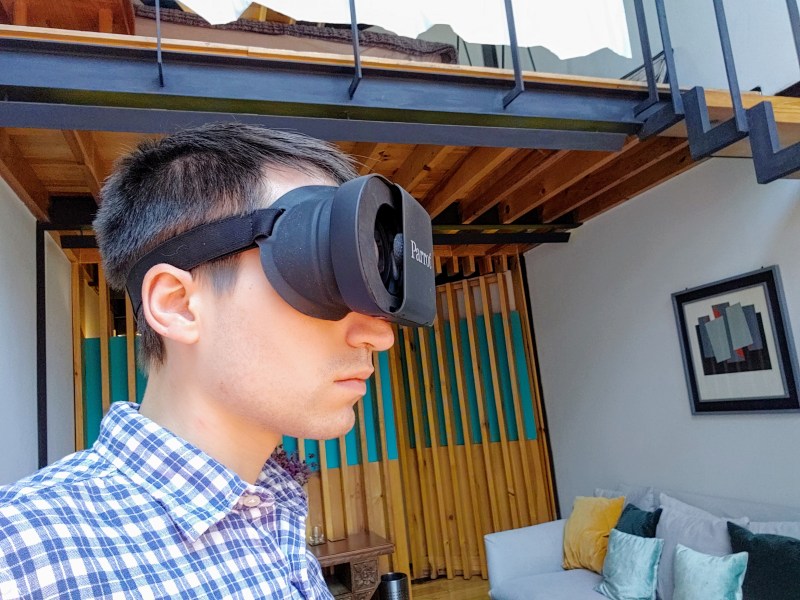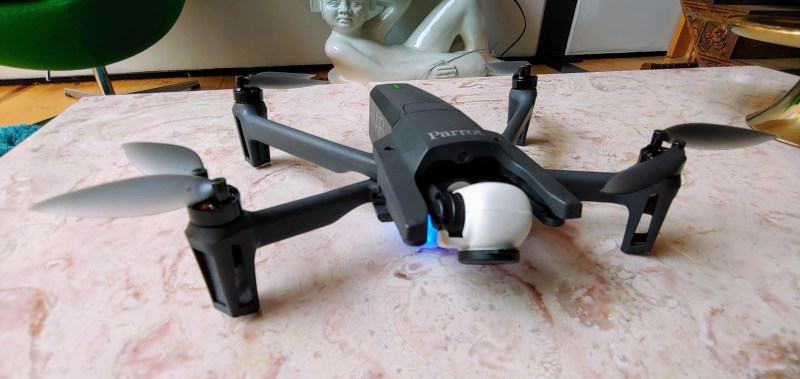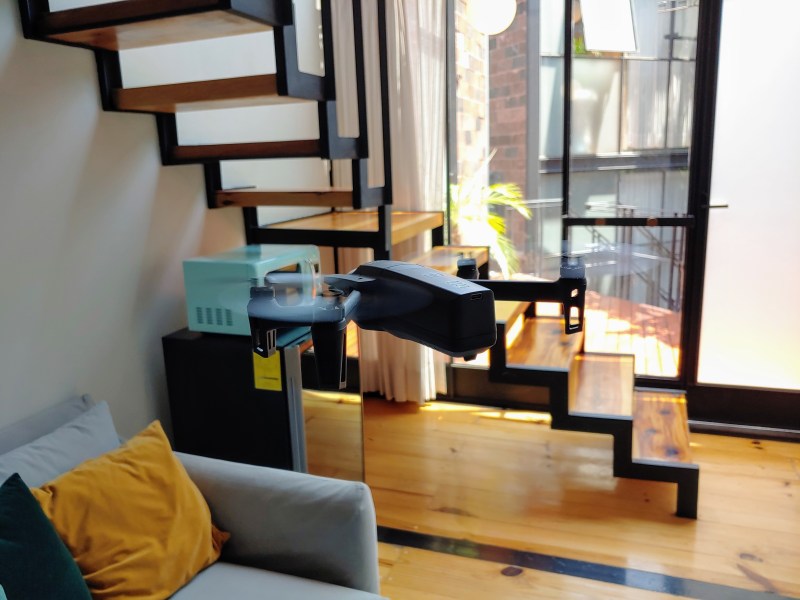Anafi. Bepop. Disco. Hydrofoil. Paris, France-based Parrot’s drone portfolio runs the gamut from fixed-winged aircraft to lightweight quadcopters, and it’s always expanding. In April, Parrot announced the Anafi Thermal, a $1,900 drone equipped with sensors and software tailor-made for rescuers, architects, and the energy industry that slotted alongside last year’s Anafi, a four-propeller drone with a Sony IMX230 camera mounted on a motorized gimbal.
Rather than return to the drawing board for its next act, Parrot opted to teach its de facto flagship, the Anafi, a few new tricks. Today, the company unveiled the Anafi FPV (the acronym stands for “first-person view”). Like the Disco FPV before it, the Anafi FPV ships with a pair of goggles that accommodate a smartphone up to 6.5 inches, much like Samsung’s Gear VR or Google’s Daydream View. Strap it to your head and you’re greeted with live footage streamed from the Anafi’s 4K high dynamic range (HDR) camera.
It’s not exactly novel — DJI’s Goggles paired with the Mavic 2 Pro offer a more or less comparable experience. But Parrot is betting that a wealth of other improvements, the bulk of which are on the software side, will sway buyers who weren’t inclined to nab the first-gen Anafi.
More of the same
The Anafi FPV is cut from the same cloth as the original Anafi. In fact, it’s identical in every respect.
You’re looking at a foldable carbon fiber mini drone that measures 241 x 315 x 64 millimeters and weighs in at under a pound (0.7 pounds, to be exact) and cuts down on noise with hollow glass microbeads packed tightly within its frame. It’s designed to furl and unfurl quickly — a practiced pilot can extend the Anafi FPV’s arms in less than three seconds, the company says.

Above: Parrot’s Cockpitglasses 3, which ship with the Anafi FPV.
Like the Anafi, the Anafi FPV can travel up to 2.5 miles or 26 minutes (whichever comes first) while zipping along at speeds upwards of 34 miles per hour. (It maxes out at vertical and horizontal speeds of 9 miles per hour and 34 miles per hour, respectively.) Its four propellers can withstand wind shear in excess of 30 miles per hour and altitudes 14,763 feet above sea level, and it is tempered to withstand temperatures ranging from 14 degrees Fahrenheit all the way up to 104 degrees Fahrenheit.
It maneuvers nimbly, but we’d be remiss if we didn’t mention the frustrating setup experience. The Anafi FPV Parrot provided to us in advance of today’s launch wouldn’t sync with our Android phone via Wi-Fi, despite about two hours of finagling. Only after we connected the included controller to the phone with a USB cable were we able to complete the pairing process and update the drone’s firmware.

Above: The Anafi FPV, with the lens cap on.
In a perhaps related problem, our unit experienced a camera failure that occasionally prevented us from capturing footage. After a bit of trial and error, we managed to stream video and transfer a few recordings from the FPV’s SD card to a paired phone. But, inexplicably, the camera sometimes wouldn’t display footage — all we’d get is a black screen accompanied by an error message.
To be fair to Parrot, we used a prerelease app for setup, which might have been the culprit. But camera issues aside, clearer instructions would go a long way toward easing the setup process.
Camera features galore
At its core, the Anafi boasts a wealth of electronics, including GPS, a barometer and magnetometer, an inertial measurement unit, an accelerometer, a gyroscope, and a USB Type-C port. But the undoubted star of the show is the 21-megapixel (f/1.2 aperture, 26-millimeter depth of focus, 1/2.4-inch sensor size) camera affixed to the end of the aforementioned gimbal (three-axis), which sports an LD aspherical lens and shoots videos in resolutions up to 4K in high dynamic range (HDR).
HDR confers the benefits of wider color gamuts and contrast, and a 100Mbps maximum recording rate improves overall quality, Parrot asserts. The Anafi FPV automatically adjusts color tone and dynamic range in response to ambient lighting conditions, such that dimly lit scenes (like sunsets) get enhanced shadow detail, while brighter environments become less noisy than they would otherwise be. And while true optical zoom is missing in action, the camera can zoom “losslessly” up to 2.8 times by cropping captures to 1080p, or up to 1.9 times with an effective resolution of 2.7K. Moreover, it can rotate in 180 degrees thanks to the gimbal, and it’s optically stabilized by a three-axis system that counteracts in-flight turbulence and instability.

Here’s the list of supported video formats:
• 4K Cinema (4096×2160 24fps)
• 4K UHD (3840×2160 24/25/30fps)
• FHD (1920×1080 24/25/30/48/50/60fps)
• HD (1280×720 48/50/60fps)
And here are the supported photo formats:
• Wide-angle: 21MP (5344×4016) / 4:3 / 84° HFOV
• Rectilinear: 16MP (4608×3456) / 4:3 / 75.5° HFOV
Beyond those basic shooting modes, the Anafi’s companion smartphone app — FreeFlight — boasts five panorama photo presets: Sphere, Little Planet, Tunnel, Vertical 180, and Horizontal 180. They’re generated from roughly a dozen stitched-together photos that take about five minutes to capture in total. Little Planet compresses the scenery into a “floating globe,” while Tunnel mode positions the sky in the center of the image. As for Sphere, which takes a 360-degree panorama, it works on VR headsets like the Oculus Rift and HTC Vive and supports Facebook’s 360 Photos feature.

Above: The Skycontroller 3.
There’s also Dolly Zoom, an homage to Alfred Hitchcock’s signature cinematographic flourish. With the tap of a button, the Anafi FPV zooms in and locks focus on trees, landmarks, and other points of interest while distorting the background.
That’s the tip of the iceberg. Hyperlapse video is in tow — you’re able to accelerate videos to 15, 30, 60, 120, or 240 times normal speed. The Cinematic preset captures “smooth” and “dramatic” video by locking the camera’s horizontal axis to the tilt of the drone, and the Racing preset — which also locks the horizontal axis — features a more “aggressive” look that’s intended to be applied to high-speed footage. They sit alongside customizable settings sliders for shutter speed, ISO, white balance, and exposure compensation, along with photography aids like an image histogram and zebra exposure assistance.
Remote piloting
The Anafi FPV’s ostensible selling point is the Parrot Cockpitglasses 3, Parrot’s newest FPV smartphone viewer, which follows the Cockpitglasses 2, and a FreeFlight app (version 6.6) with heads-up display features that take full advantage of its form factor.
The new FPV experience in FreeFlight 6.6 features a streamlined UI with an unobstructed view of the Anafi FPV’s camera feed. The HUD shows contextual information like flight speed, direction, altitude, and drone location, and it automatically highlights alerts or geofencing limits within the field of view. A click of the physical button on top of the Cockpitglasses 3 swaps to a minimal, immersive HUD interface, and switching to the new See-Through View pulls up live video from your smartphone camera with an overlay showing the position of the Anafi FPV (and an icon pointing to its location if it’s off-screen.).

The experience left something to be desired, in our limited testing. It’s difficult to adjust the Cockpitglasses such that the footage isn’t hazy or overlayed atop itself (the FPV mode splits the camera feed into two images, each of which is displayed to one eye), and the low framerate (around 30 frames per second) is likely to induce motion sickness in those with a low tolerance for virtual or augmented reality.
FreeFlight 6.6 also introduces Arcade Mode, which lets you swivel the Anafi FPV’s camera with the included controller’s left joystick while navigating the drone with the right joystick. Holding forward on the right joystick prompts the drone to travel in the direction the camera’s pointed.

The controller itself is identical to the model that ships with Anafi: The Skycontroller 3. It streams 720p video from the Anafi’s camera from up to 2.5 miles away, and it syncs to the Anafi via a USB-A port. (A USB-C handles charging duties.) Parrot claims its 2,500mAh lasts two and a half hours on a charge with an Android phone, or five and a half hours with an iOS phone.
Availability
The Anafi FPV will be available for presale and in-store from early September starting at $799. It comes with a carrying case that doubles as a launch platform, plus a battery, a 16GB SD car, and a set of extra propellers.

